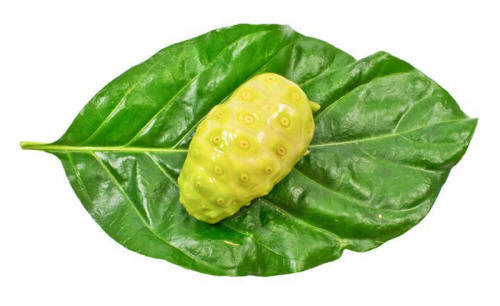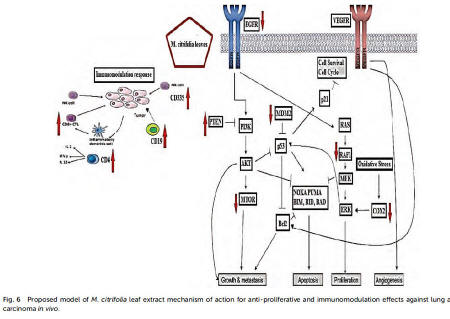|

by Sayer Ji
January 23, 2016
from
GreenMedInfo Website

Tragically,
1.4 million die from lung
cancer each year,
with 1.6 million newly
diagnosed.
Could the humble 'noni leaf
extract'
offer a more effective cancer
treatment
than a drug that can cost over
100,000 dollars,
and improves lung cancer
survival rates
by only a few months...?
A promising new study published in the
journal Food & Function titled, "Morinda
Citrifolia Edible Leaf Extract Enhanced Immune Response Against Lung
Cancer," has found that an alcohol-based leaf extract of
the
noni tree (Morinda Citrifolia) was
more effective than a commonly used chemotherapy drug in treating
lung cancer in an animal model.
In the new study, a team of Malaysian
researchers tested the relative effectiveness of the drug
erlotinib (trade name Tarceva), a
so-called epidemal growth factor receptor inhibitor (EGFR
inhibitor), to a noni leaf extract, in lung tumor-induced albino
house mice (BALB/c), and found that 21 days of treatment with a 300
mg kg-1 body weight of leaf extract was more effective
suppressing lung tumor growth than a 50 mg kg-1 body
weight erlotinib treatment.
Remarkably, the noni leaf extract was
observed to positively modulate a wide range of biological pathways,
without discernable adverse effects:
-
Increasing blood lymphocyte
counts
-
Increasing spleen tissue B cells
-
Increasing T cells
-
Increasing natural killer cells
-
Reduced epidemal growth factor
receptor (EGFR)
-
Suppressed cyclooxgenase 2
(COX2) inflammatory markers
-
Enhanced the tumor suppressor
gene (phosphatase and tensin homolog, PTEN)
-
Inhibited the tumour growth
cellular genes transformed mouse 3T3 cell double minute 2
(MDM2) and V-raf-leukemia viral oncogene 1 (RAF1)
-
Inhibited the mechanistic target
of rapamycin (MTOR)) mRNA expression in the tumors.
The study provided background on
present-day lung cancer statistics, and dismal conventional
treatment outcomes:
Lung cancer is the leading cause of
cancer-related deaths worldwide, with 1.6 million new cases and
1.4 million deaths per year.
Non-small-cell lung cancer (NSCLC)
accounts for approximately 85% of all lung cancer cases, with a
5-year survival rate of only 16%.
Chemotherapy is relatively
ineffective for patients with advanced NSCLC and the response
rate is only 20% to 35% with a median survival of 10 to 12
months.
In a phase III study, the use of
epidermal growth factor receptor (EGFR) tyrosine kinase
inhibitor (TKI) drugs, such as erlotinib, significantly improved
the overall survival rate relative to supportive care for
refractory stage IIIB/IV NSCLC.
However, erlotinib use is limited
because of several serious side effects3 and the emergence of
cancer mutations which confer drug resistance. The common
erlotinib side effects are weakness, diarrhea, rashes, shortness
of breath, coughing, loss of appetite, fatigue (feeling tired),
and nausea.
Erlotinib may cause more serious
side effects such as lung problems (shortness of breath,
coughing, and fever); interstitial lung disease and liver and
kidney problems; blistering and skin peeling; gastrointestinal
perforation; bleeding and clotting problems which may lead to
heart attacks, strokes, dry eyes, unusual eyelash growth, or
swelling of the corneas; harm to unborn babies and even death.”
Not mentioned in the study, but highly
relevant to the topic at hand, is the extraordinarily high cost of
chemotherapy drugs like erlotinib, despite the relatively small
gains they produce.
A 2010 Medscape article
reported that erlotinib, which has been the standard of care for
advanced non-small cell lung cancer (NSCLC) in the U.S. in Canada
ever since the NCIC Clinical Trials Group BR.21 trial showed a 2
month improvement in overall survival when added to supportive care
in patients who had failed all of their previous chemotherapy
options.
The article also calculated how much
these seemingly minor gains cost in dollar-per-survival year terms:
The investigators determined that
the specific cost of erlotinib treatment was $94,638 (in 2007
Canadian dollars) per life-year gained (95% confidence interval
[CI], $59,359 to $429,148).”
Clearly, if the results of this latest
animal study are found to extend to human lung cancer, as well, noni
leaf extract could provide an ideal alternative, and could be
produced at a much lower cost (A quick internet search yielded a
price of about $50 for 12 ounces).
Noni leaf, unlike conventional
chemotherapy drugs, is an
exceedingly complex biological material, containing hundreds of
different naturally occurring, and ‘intelligently interwoven’
phytochemicals.
The sheer complexity and density of
gene- and physiology-regulating information in a natural substance
like noni leaf vis-à-vis synthetically
produced, mono-chemical chemotherapy drugs, is astounding.
The article listed an immense, though
still non-exhaustive array of biomolecules identified within noni
leaf which could, together, account for the remarkable therapeutic
effects the study observed:
Scopoletin, Δ5 sterol β-sitosterol,
Δ5,7 sterol campesta-5,7,22-trien-3β-ol, (+)-catechin, α-ionone,
β-carotene, β-ionone, β-sitosterol, 1,2-dihydro-1,1,6-trimethyl-
naphthalene, 1,5,15-trimethylmorindol, 2,6,10,14,18,22-tetra-
cosahexaene, 2-methyl-
3,5,6-trihydroxyanthraquinone,2-methyl-3,5,6-trihydroxyanthraquinone-6-O-β-D-
xylopyranosyl- (1–6)-β-D-glucopyranoside, 3-hydroxymorindone,
3-hydroxymorindone
6-O-β-D-xylopyranosyl-(1–6)-β-D-glucopyranoside, 3-O-
acetylpomolic acid, 4-(3′(R)-hydroxybutyl
)-3,5,5-trimethyl-cyclo- hex-2-en-1-one, 5,6-dihydroxylucidin,
5,6-dihydorxylucidin 3-O- β-D-xylopyranosyl-(1–6)-β-D-glucopyranoside,
5,15-dimethyl- morindol, 5,15-DMM, 5-methylfurfural,
5-benzofuran car- boxylic acid-6-formyl methyl ester,
6,10,14-trimethyl-2- pentadecanone, 13-epi-phaeophorbide a
methyl ester, 13- hydroxy-9,11,15-octadecatrienoic acid,
132(R)-hydroxypheo- phorbide a methyl ester,
13(S)-hydroxypheophorbide a methyl ester,
151(R)-hydroxypurpurin-7 lactone dimethyl ester, 15(S)-
hydroxypurpurin-7 lactone dimethyl ester, alanine, arginine,
aspartic acid, asperuloside, asperulosidic acid, aucubin, barbi-
nervic acid, benzaldehyde, benzeneacetaldehyde,
campesta-5,7,22-trien-3β-ol, campesterol, citrifolinin A,
citrifolinin A-1, citrifolinin Ba, citrifolinin Bb,
citrifolinoside A, citrifolinoside B, citrifoside, clethric
acid, cycloartenol, cysteine, cystine, de-acetyl asperuloside,
deacetylasperulosidic acid (DAA), E-phytol, epicatechin, geranyl
acetone, glutamic acid, glycine, hedera- genin, histidine,
isoleucine, kaempferol, kaempferol-3-O-α-L- rhamnopyranosyl-(1–6)-β-D-glucopyranoside
kaempferol 3-O- β-D-glucopyranosyl-(1→2)-α-lrhamnopyranosyl-(1→6)-β-D-galac-
topyranoside, ketosteroid stigmasta-4-en-3-one, leucine, lino-
leic acid, lucidin, lucidin 3-O-β-dxylopyranosyl-(1–6)- β-D-glucopyranoside,
methionine, methyl oleate, methyl pheo- phorbide a, methyl
pheophorbide b, methyl plamitate, nicoti- floroside, oleanolic
acid, oxalic acid, palmitic acid, peucedanocoumarin III,
phenylalanine, pheophorbide a, phytic acid, phytol, proline,
pteryxin, quercetin, quercetin-3-O- α-L-rhamnopyranosyl-(1→6)-
β-D-glucopyranoside, quercetin 3-O-β-D-glucopyranoside,
quercetin 3-O-β-D-glucopyranosyl-
(1→2)-α-lrhamnopyranosyl-(1→6)-β-D-galactopyranoside, roseo-
side II, rotungenic acid, rutin, scopoletin, serine, stigmasta-
4–22-dien-3-one, stigmasta-4-en-3-one, stigmasterol, tannic
acid, threonine, triterpene cycloartenol, tryptophan, tyrosine,
ursolic acid, and valine.
The study concluded:
The evidence demonstrated that the
epicatechin (catechin)
and
scopoletin rich M. citrifolia
leaf extract may be used as a functional food and complementary
therapy to suppress lung cancer by stimulating the immune
responses and modulating multiple cancer cell gene signaling
pathways against cancer cell proliferation and towards
apoptosis, without producing detectable undesirable effects.
The extract suppressed key
inflammatory markers and inhibited various molecular and
cellular markers involved in proliferation and angiogenesis,
suggesting a mode of action targeting, as proposed in Fig. 6.

The epicatechin and scopoletin rich
M. citrifolia leaves may be used as a complementary/adjunct
therapy or functional food to help fight lung cancer or
adenocarcinoma”.
Incidentally, this was not the first
study to investigate the potential anti-lung cancer properties of a
noni tree component. There are several others, including:
-
In 2012, the Indian Journal
of Molecular Medicine
published a study which
found that noni fruit juice down-regulated an inflammatory
process within human lung cancer cells, indicating it might
play a therapeutic role in inflammation-associated lung
pathologies, including but not limited to lung cancer.
-
In 2001, the Annals of the
New York Academy of Sciences
published a study that
found noni fruit juice was capable of preventing
carcinogenic DMBA-DNA adduct formation in the lungs of mice,
indicating its likely cancer preventive properties.
-
In 1999, the journal
Phytotherapeutic Research
published a study which
found that the fruit juice of noni had antitumor activity in
a mouse model of Lewis lung cancer.
It should be emphasized that the noni
tree is certainly not the only natural substance that has been
studied to provide natural chemopreventive and chemotherapeutic
activity against lung cancer.
Indeed, we have indexed 129 additional
natural substances, many of which are foods, that have demonstrable
anti-lung cancer activity.
Curcumin, since it is able to
target the cancer stem cells at the heart of lung cancer malignancy,
may be the most promising of them all.
Consider that lung cancer is one of the
most commonly over-diagnosed and over-treated cancers in existence
today,
as identified in an important 2013 JAMA report
commissioned by the National Cancer Institute.
So, always get a second opinion
and do your own research so you can make as much of an informed
choice as possible...
|



